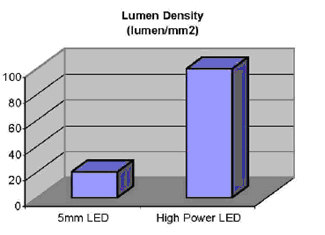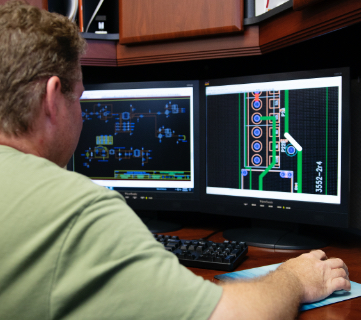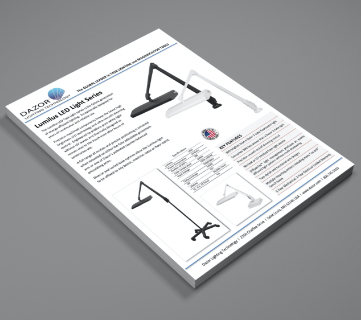High Power LED Lighting
LED technology has recently advanced to a stage that it is now a viable and reliable illumination option to other forms of lighting commonly used in task lights. Today's High Power LEDs produce accurate and consistent colors of white light without ultraviolet or infrared wavelengths. They are also endorsed by government and private research institutions because of the significant energy, maintenance, and environmental benefits they provide.
Dazor is now helping to bring this technology from research and development into commercialization with its introduction of our new line of LED powered task lights. Why choose LED?
Increased Light Output / No Glare
Traditional illumination sources like fluorescent, incandescent, and halogen are omni-directional; that is, they emit light in all directions. Illumination from these lamps must be re-directed toward the work surface using reflectors in the fixture. However, each time illumination is reflected, a certain amount gets lost. Some of the light gets trapped behind the lamps and never gets out of the fixture, while other light makes its unwanted way into a person's eyes in the form of glare. Depending on fixture design, up to half the light generated by an omni-directional illumination source may not make it to the desired work surface location.
The light emitted from an LED is directional. The directed nature of LEDs can result in up to 95% of the illumination ending up at the desired point on the work surface. Therefore, with a properly designed LED fixture, less total light output is required to provide the same level of illumination at the desired location.

Figure 1 compares the lumen density from a standard 5mm white LED to a High Power white LED. The High Power LED delivers 5X the lumen density of a standard 5mm LED.
Longer Life
Because fluorescent and incandescent illumination sources use filaments in their design, the end of life for these technologies typically occurs with a total failure of the bulb. In fact, the average rated life for a typical incandescent bulb is 1,800 hrs while fluorescent bulbs average about 7,500 hrs.
LED technology, on the other hand, does not allow for the LED source to catastrophically fail. Rather, the amount of light output simply decreases over time and this can be minimized through proper packaging design, power regulation, and thermal management.
Light output from High Power LEDs depreciates negligibly over time giving them a full service life of over 50,000 hours without any color degradation. There is no point in time at which the light source stops functioning.
Improved Color Quality and Consistency
Dazor has combined state-of-the-art High Power LEDs and an innovative thermal system design within its unique fixturing, which substantially minimizes any color variation in white light over the product life. In Dazor's LED fixtures, there is no need for secondary devices to dissipate heat, such as irritating cooling fans or pipes.
To ensure color consistency, LED manufacturers use specialized automated optical measurement equipment to test each individual LED. After optical testing, each individual LED is sorted and stored according to its specific color temperature bin as well as its flux (light output) and forward voltage (electrical). This classification process allows Dazor to select the proper LEDs for devising task lights that produce the desired illumination properties for specific applications.
Reduced Energy Consumption
Today's High Power LED's consume 1 watt of electricity (higher wattage LEDs are in development and even available in certain commercial applications). Traditional measurement of light efficiency is known as "luminous efficacy", which measures how much light output (lumens) a light source emits in comparison to how much energy it consumes (watts of electricity). The luminous efficacy of a light source is quantified in "lumens per watt".
Luminous efficacy is an important indicator of light efficiency, but it doesn't tell the whole story, particularly with regard to High Power LED light sources.
Due to the directional nature of their light emission, LEDs potentially have higher application efficiency than other light sources because more of the light output from an LED actually hits the target it is intended to illuminate.
In addition to requiring less energy to power an LED than traditional light sources, LEDs have other environmentally friendly characteristics. They contain no mercury or gas and emit no infrared or ultraviolet radiation. Also, most High Power LEDs are lead-free and RoHS compliant.
No UV and No IR
LEDs present very real and unique illumination opportunities that are new and relevant to the world. At no other point in history has an unfiltered illumination source been available that is intrinsically devoid of infrared and ultraviolet wavelengths from the light beam within the commonly used range of white colors. This creates interesting challenges and opens doors for development of new LED light fixtures designed for use in applications where color correct light output is critical to the visual task.
Reduced Glare & Hot Spots
Not only do High Power LEDs emit directional light, but Dazor LED light fixtures and desk lamps use secondary optics to further control the direction of the light output onto the desired work area. This technology allows for the diffusion of the directional light in a controlled manner, eliminating "hot spots" on the work surface and also eliminating glare. In doing so, LED desk lamps reduce the fatigue effects that occur during everyday work that are commonly associated with the omni-directional lighting produced by fluorescent and incandescent lights.
High Vibration Resistance
High Power LEDs (solid-state devices) have no moving parts, no filament, and no fragile glass shell. This represents a considerable practical improvement to luminaries which house traditional glass bulbs. The likelihood of bulb breakage occurring during the shipment of light fixtures and desk lamps can be substantial due to the quality of fixture packaging, in combination with the commercial means commonly available to transport and distribute light fixtures and desk lamps. The risk of bulb breakage is virtually eliminated with LED solid-state devices.
Dimmable and Instant Start
LEDs are infinitely dimmable without sacrificing any characteristic of the light. There is no deterioration of color when the light fixture and drive electronics are properly designed, despite declining light intensity. In addition, LEDs start instantly and emit full color and light intensity at a temperature as low as -40C.
Better Thermal Management
Traditional illumination sources dissipate heat forward by emission of infrared radiation (IR) wavelengths and through conduction or convection of heat by design of the fixture. Conversely, High Power LED technology requires all heat from LEDs be conducted away from the LED chip. So while, the forward light path emitted from a halogen or incandescent bulb is hot, LED radiates negligible IR so there is no heat in the light path. Any heat generated when the LED is illuminated is conducted back through the board, its fixture, and ultimately dissipated into the surrounding atmosphere.
Dazor's light fixture design uses High Power LEDs that incorporate a separate heat sink into their packaging, which dramatically improves heat transfer between the blue light emitting surface (the "chip" or "die") and the electronic mounting board. In addition, the drive electronics are specially engineered to control the amount of electric current input at critical thermal junction points. Engineering the total light fixture package with proper thermal design as a primary consideration allows Dazor to use a higher electrical current to drive the LEDs. This thermal design and heat management system increases light output while protecting LED color consistency and life of operation.
In Conclusion...
Today's LED High Power LED technology can be used as a viable, cost effective, color accurate, lighting alternative to traditional illumination sources. Unique characteristics of LEDs allow this technology to not only be a basic source of illumination, but also to be the light source of choice in many task applications where visual precision is needed.




